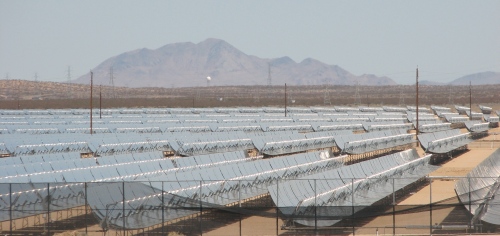California utility PG&E will buy 106.8 megawatts of electricity from a hybrid biofuel solar power plant to be built by a Portuguese firm in the state’s Central Valley.
The hybrid technology will allow two 53.4 megawatt plants to tap the sun and agricultural waste produced in surrounding Fresno County to generate green energy around the clock, according to San Joaquin Solar, a subsidiary of Portugal’s Martifer Renewables. For PG&E (PCG), 107 megawatts is just enough to keep the air conditioners running for some 75,000 homes. But if the biofuel solar hybrid performs as billed and can be scaled up, it’s a win-win – recycling ag waste – a huge and expensive problem in California – into electricity.
The percentage of electricity to be produced by solar versus biofuel and other details of the project’s design are sketchy. Andrew Byrnes, an executive with Spinnaker Energy – the San Diego company developing the project for Martifer – told Fortune that such information is “confidential” as are images of what the hybrid plant will look like and the identities of the company’s U.S. investors.
Here’s what we do know: San Joaquin Solar 1 and 2 will be built on private land outside the farming town of Coalinga. They will use long arrays of curved mirrors called solar troughs to focus the sun on liquid-filled tubes to produce steam that will drive electricity-generating turbines. That’s a standard solar technology currently operating in California and elsewhere. The biomass component of the plant will use agricultural waste, green waste and livestock manure to create heat that will generate steam.
It appears the biofuel will be used to keep the plant running at night or on overcast days. “The technologies can run simultaneously,” said Byrnes in an e-mail. “And when a cloud passes overhead (and after the sun sets) the solar facility can still generate energy, since the generation process is dependent on heat rather than direct solar radiation.”
While there is a natural gas-solar hybrid power plant under development in Southern California – see Green Wombat’s “The Prius of power plants” – San Joaquin Solar 1 and 2 will apparently be the world’s first biofuel solar hybrid.
Each power plant will each need 250,000 pounds of biomass a year to operate. Finding that fuel shouldn’t be a problem: Byrnes says a study shows that Fresno County alone produces nearly 2 million tons of ag waste annually.

Now, here’s a good idea. It seems like there will be less variability due to the constant nature of a biomass plant with a steady fuel source.
Converting solar power in the desert to heat water to generate steam, to turn a turbine to create electricity and send it many miles ot users is VERY inefficient and expensive.
A much more cost effective solar power device is a cloth rope stretched taut between two level points. Placing wet material on this device converts solar power into evaporative power resulting in a magical drying of the material.
That’s right, using a clothes line rather than a clothes dryer would be a highly distributed solar power strategy that requires minimal capital investment and eliminates the need to power one of the most power hungry devices in a home. In most homes the dryer not only does its job, it generates vast amounts of heat that the home’s air conditioner then works to remove.
If people don’t want their underwear on public display, one could simply dry things like towels, rugs, sheets, socks, shirts and pants outside. It’s natural, organic, results in a fresh smell, no static, and eliminates the need for dryer sheets like Bounce.
Yeah. And, depending where you live, like a dense urban environment, your air-dried clothes will have that desireable tail pipe smell.
Better yet. Why not forget about washing your clothes all togetehr. That is really energy efficient.
Biomass can generate CO2, either directly or through the burning of the methane it produces. Do they plan on capturing that?
How is it inefficient to hook up a few wires from that powerlant to a few of the many high tension transmission lines that run EVERYWHERE?
Simply vapid!
A lucricrous waste of tax dollars to stuff the pockets of some favored croonies. I wonder just whose private land this project is being built on.
Current solaris projects are plagued by problems of scale. Problems of scale that disappear when individual dwellings are outfitted to independently generate their own power. Problem then is politicians and business then loose much of their ability to function as co-parisites of their citizens/customeers.
‘ag waste’ is anything but…this material needs to be reincorporated back into the soil to avoid poisoning the soil with too many metals when applying artificial fertilizers.
Interesting concept, I would love to know how much the solar is rated for. I hope it is more than the 10% or so the Victorville one is rated at. It seems like it would be a good match for a conventional steam plant. I do have some doubts about the cost effectiveness of putting the solar collectors in the central valley of California. I guess time will tell. There are a large number of projects announced in California and only 4 who have actually applied with the energy commission to be built. My guess is most are simply on a fishing expedition for funding and PG&E is getting great press.
Transmission lines are a huge issue for renewable energy. Yes there are lots of transmission lines everywhere but most of the capacity is already spoken for. This is something we are going to have to deal with if we do renewables or now. In Texas now this is a big issue for wind and many of the choice solar areas (those close to both water and natural gas) in the Mojave need to have the transmission lines upgraded. This is both expensive and time consuming.
Biomass is carbon-neutral–The carbon it releases is carbon that it took from the environment as it was growing.